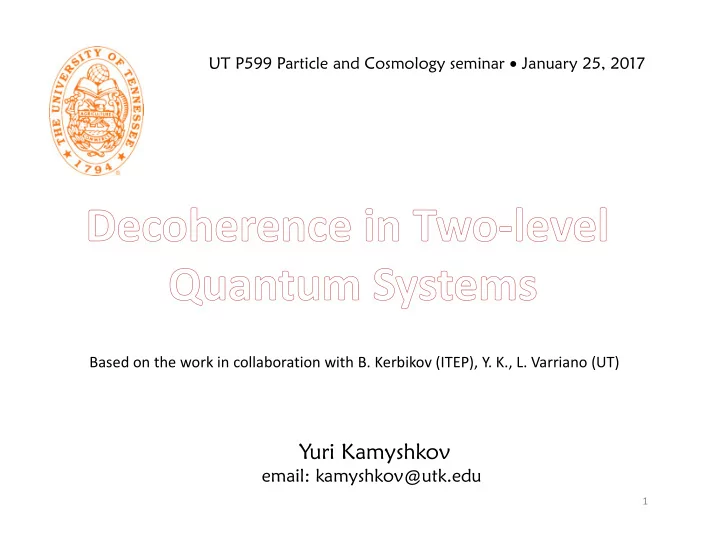

UT P599 Particle and Cosmology seminar • January 25, 2017 Based on the work in collaboration with B. Kerbikov (ITEP), Y. K., L. Varriano (UT) Yuri Kamyshkov email: kamyshkov@utk.edu 1
http://en.wikipedia.org/wiki/Two-state_quantum_system Examples: - electron spin precession in mag. filed - NMR - Chemistry � oscillations In Particle Physics: - neutral � ↔ � - neutrino flavor oscillations - oscillations of � → � � - oscillation of � → � � mirror state 2
: 3
In general Hamiltonian with mixing leads to oscillations between two components. � when E.g. neutron oscillation : Hamiltonian is Hermitian matrix unitary Oscillation frequency 4
� � � � � � � Probability doesn’t depend on E but on . 5
There are more general description with density matrix L. D. Landau and E. M. Lifshitz, Quantum Mechanics, Course Theoretical Physics v. 3 • • R. P. Feynman, Statistical Mechanics, A Set Of Lectures (Advanced Books Classics) • https://en.wikipedia.org/wiki/Density_matrix |�˃ = 1 0 ; |� � ˃ = 0 1 Mixed state: � �′ = � 1 0 + � 0 1 ; � � + � � = 1 = � �� � �� � = �� ∗ �� ∗ � � �� − density matrix � �� �� ∗ �� ∗ � � · � �� � � �� � � = −� � � = −�� � + �� �� �(� = 0) = 1 0 � 0 0 Liouville–von Neumann equation for density matrix evolution 6
Hamiltonian can be more complex, e.g. for the oscillating neutron moving through the gas (no mag. field) � � � � � we should expect for frequency: Proper Real potential diff. oscillation increases frequency � � � � Frequency of Absorption the system damping � = 7
For even more general case of the complex potential, decay, and including magnetic field and spin: System of 16 coupled diff. eqs can be handled by Mathematica 8
9
Thi description by Liouville–von Neumann equation is still not complete � � · � �� � � − Liouville–von Neumann equation �� � � = −� � � = −�� � + �� �� Direct interaction with environment via incoherent elastic collisions is not included. This will lead to decoherence. “Most general evolution of probabilities satisfies an equation of a class known as Lindblad equations.” http://www.nybooks.com/articles/2017/01/19/trouble-with-quantum-mechanics/ 10
https://en.wikipedia.org/wiki/Lindblad_equation This equation includes in general the loss of coherence of oscillating system to environment. Loss of coherence is the reset of the oscillation phase between two components. At this moment oscillating system collapses (with some probability) into one of its pure states and continue motion with this boundary conditions. It is “measurement” of the system by the environment; system remains in the oscillating state with reset boundary conditions. 11
Example of decoherence of two-level system in old classical paper Measurement of the system (the effect): � � decay with emission of Michel � s � � ; or inelastic collision with molecules e + e - leading again to the decay of the � � � � m - m + 12 Here the evolution equation for � ha s resulted into simple form of Lindblad equation
13
(1) 14
(2) 15
(1) (2) 16
It looks like the Lindblad “super-operator” term is coming here from the incoherent elastic scattering of oscillating system on the molecules of environment. 17
… and produces a decoherence effect on oscillation. Probability of oscillation in vacuum 18
Scattering Integral in Feinberg & Weinberg evolution equation � � = � � (�) 0 0 � � (�) Source of decoherence � � �� ∗ � � �� � ∗ � � �� � �� � Will be zero if one of f’s is zero 19
Loss of COHERENCE is due to scattering integral Absorption and decay make here negative contribution In the vacuum the probability � �� coherently grows as ~� � [ ��� � (��) ] . Every incoherent elastic collision resets the oscillating system’s phase to zero, but the system continues its motion in the environment contributing (with + sign) to the evolution of � until it is being P “measured” at some later time. = measurement P 0 M Weinberg’s recommendation is to N make number of collisions < 1. That is the reason why current muonium oscillation search experiments are being performed in vacuum or with zero ������������ ����� t pressure. 20
Loss of coherence in transformation? In ESS n-nbar experiment with L=200-m vacuum vessel and residual pressure is < 10 �� • ��� or < 10 �� �� , vacuum gas H 2 , with total cross section 82 barns for thermal neutrons (overestimate), the probability of elastic collision for the neutron component with gas molecules is ��� ≲ 10 �� per flight. Elastic x-section for � � component is not well known but its x-section is not larger than for ��. If incoherent elastic scattering will occur to oscillating �� � system in the beam, the • �� � system will be scattered isotropically in s-wave and will be mostly removed from the beam. So it will not contribute to the evolution of � matrix through scattering integral, since the system after scattering can not be measured. Conclusion: for �� � oscillation in gas with residual pressure < 10 �� ���� the evolution equation has the form : � without scattering integral introducing decoherence. 21
Recommend
More recommend